

10+ Best Grounding Techniques and Exercises to Strengthen Your Mindfulness Practice Today. In this post we will be… oh… are you still here?
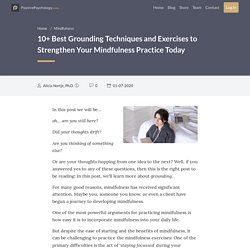
Did your thoughts drift? Are you thinking of something else? Or are your thoughts hopping from one idea to the next? Well, if you answered yes to any of these questions, then this is the right post to be reading: In this post, we’ll learn more about grounding. A Basic Meditation to Strengthen Neural Connections. We are all born with a specific set of physical parameters, but if we eat right, take care of ourselves, and work out, we can build muscle, flexibility, and endurance.

The same is true for our minds: We can change our brain, boosting concentration, flexibility, and intelligence and building new neural pathways and networks, by working out our brain, particularly with mindfulness and related practices. Take a moment right now to try this basic mindfulness meditation for yourself. Before you begin, adopt a posture that is both comfortable and sustainable for a few minutes, and then set a timer for three minutes. First, bring your awareness to an anchor: sensations or movement in your body, the breath, ambient sounds, counting, or even an image you found powerful or calming. Anything can be the anchor for your attention. Mindfulness Meditation: 8 Quick Exercises That Easily Fit into Your Day.
You can fit these mindfulness exercises into your life while walking, brushing your teeth and just listening.
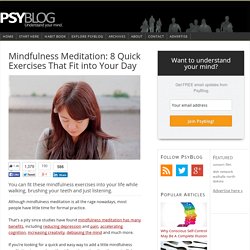
Although mindfulness meditation is all the rage nowadays, most people have little time for formal practice. That’s a pity since studies have found mindfulness meditation has many benefits, including reducing depression and pain, accelerating cognition, increasing creativity, debiasing the mind and much more. If you’re looking for a quick and easy way to add a little mindfulness meditation to your day without formal practice, then these mindfulness exercises are for you. They mindfulness exercises can mostly be slotted in while you go about your everyday business, without the need for a formal sit-down meditation session. 1. If you do any period of undisturbed walking during the day — at least ten or fifteen minutes — then you can do a little walking mindfulness meditation. It’ll be easiest if done somewhere with fewer distractions, but try it anywhere and see what happens. 2. 3. 4.
Overcome the Five Obstacles to Your Mindfulness Meditation Practice. Many media outlets have been talking for a number of years now about how ubiquitous mindfulness is, the impact it’s having in a variety of sectors and all the wonderful science that continues to be published.
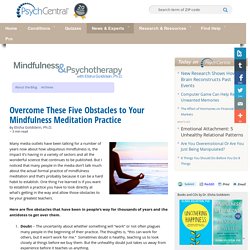
But I noticed that many people in the media don’t talk much about the actual formal practice of mindfulness meditation and that’s probably because it can be a hard habit to establish. One thing I’ve learned is if you want to establish a practice you have to look directly at what’s getting in the way and allow those obstacles to be your greatest teachers. Here are five obstacles that have been in people’s way for thousands of years and the antidotes to get over them. Doubt – The uncertainty about whether something will “work” or not often plagues many people in the beginning of their practice.
4 Ways Mindfulness Meditation Benefits So Many Conditions. Four central components of how mindfulness meditation works, psychological research finds.
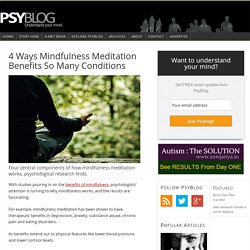
With studies pouring in on the benefits of mindfulness, psychologists’ attention is turning to why mindfulness works, and the results are fascinating. For example, mindfulness meditation has been shown to have therapeutic benefits in depression, anxiety, substance abuse, chronic pain and eating disorders. Its benefits extend out to physical features like lower blood pressure and lower cortisol levels. How is it that this type of practice can have these beneficial effects on such a broad range of conditions? A recent study by Hölzel et al. (2011) finds four central components to how mindfulness works: 1.
Awareness of your own body has long been taught as one of the foundations of mindfulness meditation. The Buddha says the mindful monk finds through… Being mindful may also help with empathising with others because knowledge of the self provides insight into others. 2. 3. 4. The Dalai Lama says: 60 Seconds to a Stress-Less Life (and a More Compassionate World) The Now Effect is based on a very simple quote from a psychiatrist and holocaust survivor named Viktor Frankl.
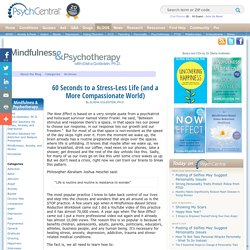
He said, “Between stimulus and response there’s a space, in that space lies our power to choose our response, in our response lies our growth and our freedom.” But for most of us that space is non-existent as the speed of the day skips right over it. From the moment we wake up, the brain already has a routine preplanned that skips over the spaces where life is unfolding. It knows that maybe after we wake up, we make breakfast, drink our coffee, read news on our phones, take a shower, get dressed and the rest of the day unfolds like this. Sadly, for many of us our lives go on like this until some crisis wakes us up. Philosopher Abraham Joshua Heschel said: “Life is routine and routine is resistance to wonder.” The most popular practice I know to take back control of our lives and step into the choices and wonders that are all around us is the STOP practice. The Power of Silence. Self-Compassion. Loving-Kindness Meditation.
Mindfulness. The Science and Practice of Staying Present Through Difficult Times. The Science of Staying Present Research into mindfulness has shown the benefits of staying present, and of gently turning towards difficulty.
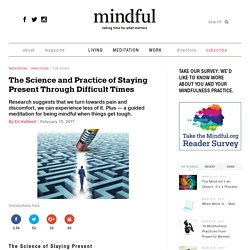
Mindfulness-based relapse prevention (MBRP) trains people with addictive habits to manage their cravings mindfully by staying present to the sensations of craving, rather than trying to distract from them, avoid them or defeat them. In a large trial of MBRP, mindfulness-trained patients drank and used drugs significantly less than those who were treated with cognitive-behavioural approaches, and a control group who attended twelve-step and psycho-education groups. The authors of the study conclude that mindfulness was the most successful approach, especially over the longer term, because it enabled patients to “monitor and skilfully cope with discomfort associated with craving or negative affect.” When gently turning towards pain, people report that they experience less of it, and their resistance usually decreases.
It’s okay. A Reconciliation Meditation. Mindfulness Meditation: Guided Practices. Body Scan Meditation When doing this meditation, remember that, as always, there’s no need to strive to make anything happen.
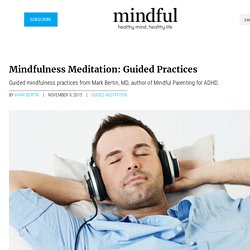
Simply observe what you find and practice letting things be for a while. When something uncomfortable grabs your attention, like pain or an itch, observe it first and see if it changes. If you find you need to address it, that’s fine. Noticing that, pause and make an adjustment. Begin by lying down or sitting in a comfortable chair. Take a few moments to notice sensations of breathing.